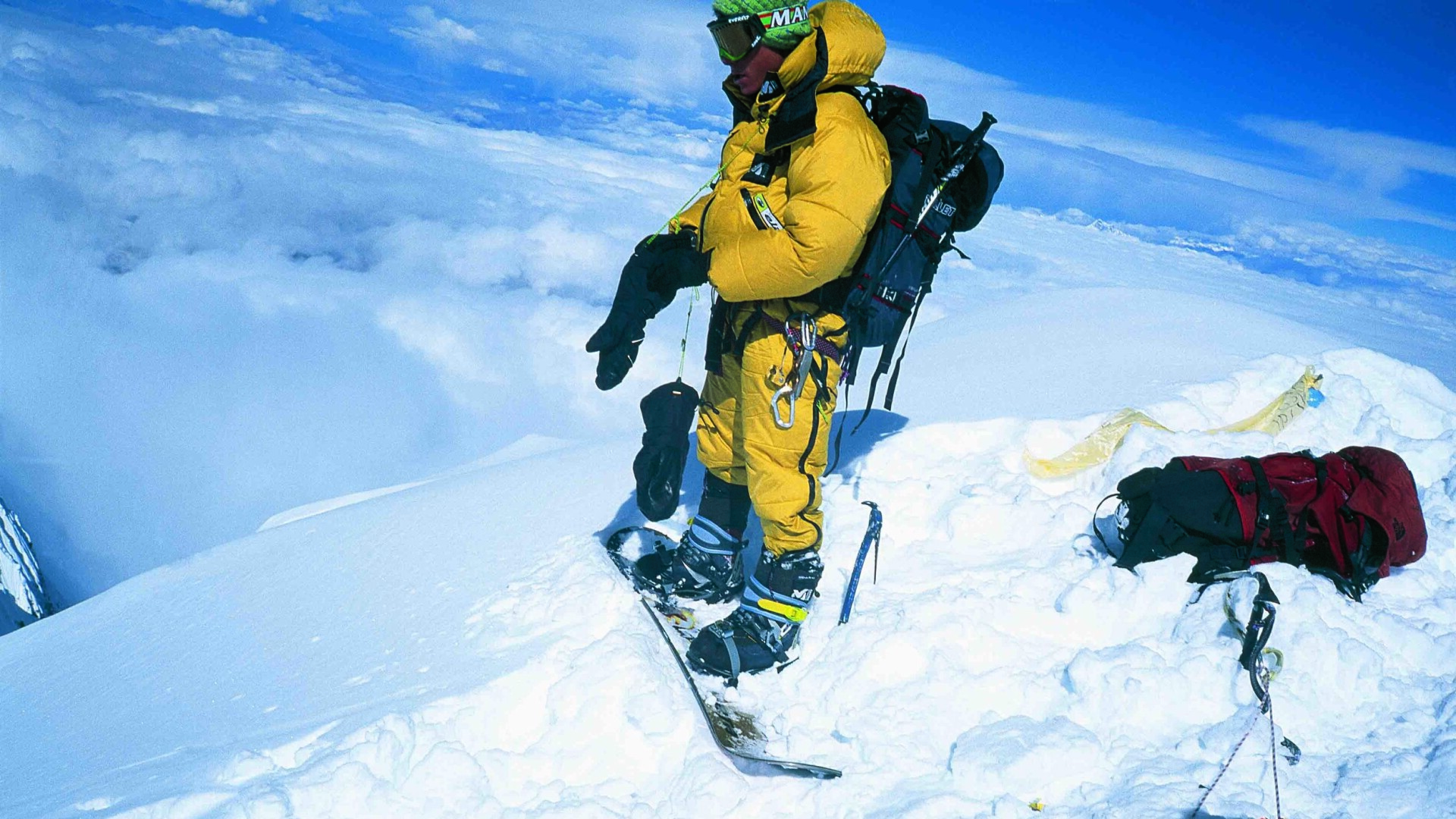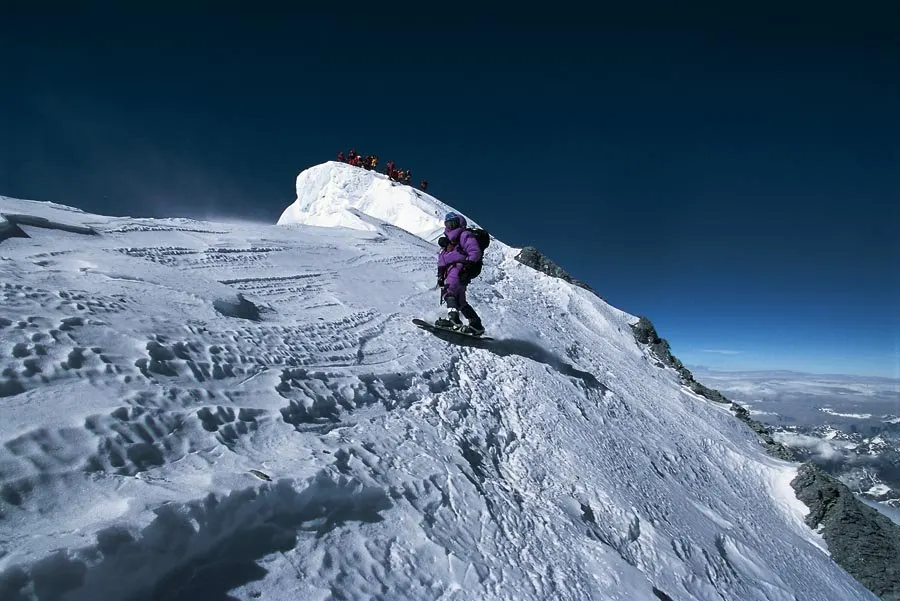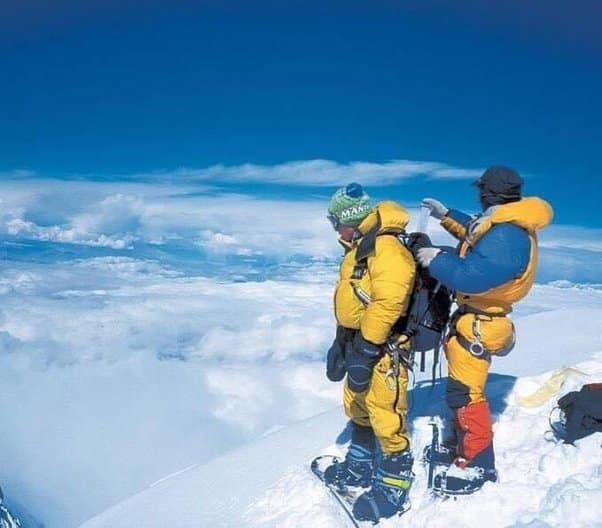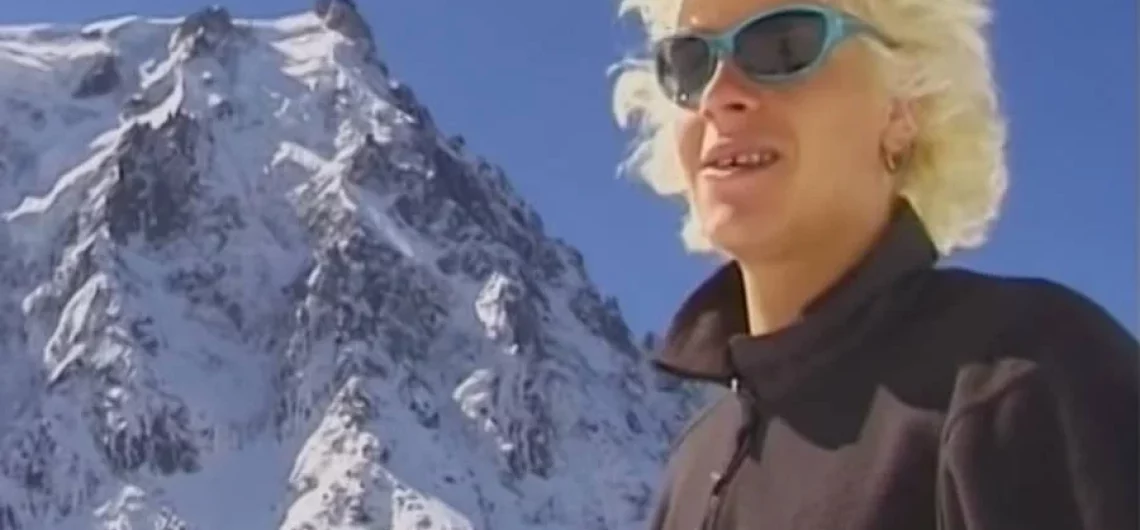Marco Siffredi was a renowned snowboarder who was born in France in 1979. He gained international fame for his daring expeditions to the world’s highest mountains, including Mount Everest, which he famously snowboarded down twice. Unfortunately, his life was cut short at the young age of 23, when he lost his life on his final snowboarding expedition. He was known for his daring expeditions to some of the world’s highest peaks. Unfortunately, his life met a tragic end when he disappeared during his third attempt to snowboard down the Hornbein Couloir on the northern face of Mount Everest.
In the year 2001, Marco Siffredi accomplished an incredible feat by successfully snowboarding down the entirety of Mt. Everest. This daring achievement pushed the boundaries of what was considered possible at the time. However, Siffredi’s ambition did not end there. In 2002, he set his sights on an even more audacious goal – conquering the challenging Hornbein Couloir. Siffredi was a snowboarding prodigy who hailed from Chamonix, a place renowned for its skiing and snowboarding culture. Sadly, tragedy struck in September 2002 when he went missing while attempting a snowboard descent through the famous Hornbein Couloir. At the young age of 23, Siffredi was already recognized as one of the most accomplished extreme skiers and snowboarders of his time. Prior to his disappearance, Siffredi had achieved numerous daring first descents in the vicinity of his family’s home near the Aiguille du Midi. In 2001, he etched his name in history by becoming the first person to fully snowboard down Everest, all the way from its summit to the advanced base camp, via the treacherous Norton Couloir. By accomplishing this remarkable feat in 2001, Siffredi had seemingly proven his expertise and skill in the niche world of extreme snow sliding. However, according to Evans, a renowned authority in the field, Siffredi, despite being seen as an introvert, still thirsted for greater recognition. Just a year after his Everest triumph, he embarked on a quest to conquer the illustrious Hornbein Couloir – a descent that is widely regarded as the ultimate achievement in extreme snowboarding.
Early Life and Career
Marco Siffredi was introduced to snowboarding at a young age and quickly developed a passion for the sport. He began competing in snowboarding events in his teenage years, and his talent soon caught the attention of professional snowboarders and sponsors. He went on to win several snowboarding competitions, including the European Snowboard Championships.
Siffredi was always drawn to extreme snowboarding, and he became known for his daring expeditions to some of the world’s highest peaks. In 2001, he successfully snowboarded down Mount Everest, becoming the first person to achieve this feat. He went on to repeat the stunt in 2002, further cementing his reputation as a fearless snowboarder.
Events Leading up to Disappearance
On September 8, 2002, Siffredi set out on his third attempt to snowboard down the Hornbein Couloir. He had previously completed the same feat twice before and was considered an experienced and skilled snowboarder. However, this time he encountered difficult snow conditions and fell while attempting to navigate a difficult section of the mountain.
A timeline of what happened on the fateful Everest climb by Marco Siffredi
 Mount Everest is the world’s highest mountain, and Marco’s adventure began in the spring of 2001 when he left with Himalayan Expeditions for Everest. Ahead of him was Dr. Stefan Gatt from Austria, an experienced rider/Alpinist who had already scored a successful snowboard descent of Cho Oyu. Despite Gatt’s decision to climb without the assistance of Sherpas or supplemental oxygen, making the attempt infinitely more difficult, the two riders shared the same goal. It would be a race to see who would become the first person to score a snowboard descent of Everest.
Mount Everest is the world’s highest mountain, and Marco’s adventure began in the spring of 2001 when he left with Himalayan Expeditions for Everest. Ahead of him was Dr. Stefan Gatt from Austria, an experienced rider/Alpinist who had already scored a successful snowboard descent of Cho Oyu. Despite Gatt’s decision to climb without the assistance of Sherpas or supplemental oxygen, making the attempt infinitely more difficult, the two riders shared the same goal. It would be a race to see who would become the first person to score a snowboard descent of Everest.
Marco’s original plan was to summit and descend by the Hornbein Couloir, but when he arrived at the mountain, there was hardly any snow on the windswept summit. He had left in spring, hoping for lighter snow conditions that would increase his chances of summiting. However, those same conditions made it impossible for him to realize his original plan. As the climbers moved up the mountain, enough snow accumulated to enable the descent via plan B, the Norton Couloir.
Finally, on May 23, 2001, the day after his 22nd birthday, Marco summited the mountain. He was determined to make a snowboard descent of Everest, and he dropped in and started making turns past the long line of exhausted climbers. Unfortunately, not far from the summit, his binding broke in the extreme high-altitude cold. Lucky for him, one of the Sherpas was able to fix it with bailing wire, and Marco entered the couloir, shredding 1,800 meters on slopes of 40 to 45 degrees. He stopped at the North Col to rest for an hour before finishing off the last 1,000 meters and arrived at Advanced Base Camp less than four hours after leaving the summit.
At Base Camp, the team was already on the satellite phone, and within minutes, the amazing news had spread to every corner of the snowboarding universe. Although Gatt had summited less than 24 hours ahead of Marco, he had taken his board off and down-climbed past 100 meters of the steepest terrain. Because Marco rode all the way from the summit back to Advanced Base Camp, his historic descent was recorded as the first continuous snowboard descent of the world’s highest mountain.
After the successful descent of Everest, Marco’s ultimate goal was to reach the Hornbein Couloir, the true North Face of Everest. In the fall of 2001, he summited Shishpangma, the 14th highest peak in the world, without his snowboard due to high winds. However, Marco and his Sherpa friend Phurba, along with Russell Brice and Loppasang Temba Sherpa, spent the following summer in Chamonix, where they planned a second Everest attempt.
On Thursday, August 8, 2002, Marco left Chamonix but forgot the good-luck cross he had always taken with him in the past. He arrived in Katmandu and made his way to the Hotel Tibet, where he met Phurba, Pa Nuru, and Da Tenzing, three Sherpas who would play an essential role in getting him and his equipment to the summit of Everest.
On Saturday, August 10, 2002, the team left Katmandu and drove north toward Tibet. As part of Marco’s acclimatization, he spent a night at Kodari on the Nepal/Tibet border, then Nyalam, a town that would seem to exist solely as a way station for climbers and trekkers if it weren’t for the massive building projects undertaken by the team.
Wednesday, 28 August 2002: The group does a pre-trip to the North Col and bivouacs. A storm comes in overnight, and they arrive the next day in severe weather. Marco straps in and rides down with the Sherpas filming footage close to the fixed ropes.
Thursday, 29 August, 2002: Marco and his team rest at the South Col before making their final push to the summit. At around 9:30 pm, they leave the South Col and start making their way up the mountain. The night is cold, and the winds are strong, but they continue to climb, taking small breaks every few steps to catch their breath and check their gear. As they near the summit, they pass the body of another climber, and Marco thinks about the dangers and risks that come with climbing such a formidable peak.
Friday, 30 August, 2002: At around 6:30 am, Marco and his team reach the summit of Everest. The view from the top is breathtaking, and Marco takes a moment to soak it all in. He feels a sense of accomplishment but also knows that the hardest part of the journey is still ahead of him. They spend about half an hour on the summit before starting their descent. The team moves slowly and carefully, taking their time to avoid making any mistakes.
Saturday, 31 August, 2002: After a grueling descent, Marco and his team make it back to the South Col. They rest for a few hours before continuing their descent to Base Camp. Marco thinks about the challenges of climbing Everest and the lessons he’s learned along the way. He knows that the journey has changed him in ways he never expected.
As he sits in Base Camp, Marco thinks about the next chapter of his life. He knows that he’ll continue to climb and explore, but he also knows that there’s more to life than just conquering mountains. He thinks about the people he’s met along the way and the experiences he’s had. He knows that those are the things that truly matter in life.
On September 2, 2002, the team woke up to snowfall, hoping for a better weather forecast so that they could proceed towards Camp 3. The Sherpas decided to carry their huge packs and make a push towards Camp 3, but due to the worsening weather conditions, they had to stash the gear at 7,700 meters and return. Marco, on the other hand, considered sending the Sherpas to establish Camp 3 at 8,300 meters and come back down. Yann gave a weather forecast, indicating that small flurries were expected in the coming days but Sunday, September 8 would be a bluebird day, which would be his summit day. Excited about the news, Marco tells the camera that the hardest is yet to come, and his summit day is still ahead.
Meanwhile, Olivier Besson, a mountain guide from Megà¤ve, France, is rushing to catch up to Marco. Phurba Sherpa encourages Marco to wait for Olivier, who will bring a repaired radio with him. However, Marco is convinced that he should take the opportunity and set out without Olivier.
On September 6, 2002, the team embarked on their summit push. Marco left Camp 2 and reached 7,900 meters, while the Sherpas continued to 8,300 meters to establish High Camp. The day was bright and sunny, and Marco stood outside in his shirtsleeves at almost 8,000 meters to make the day’s phone calls. Although he informed his friends of his progress, he tells his parents that he is still at ABC, not wanting to cause them any additional distress.
On September 7, 2002, Marco made his way to Camp 3, officially entering the Death Zone. Above 8,000 meters, the human body can no longer regenerate and will eventually die. The altitude is taking its toll, and Marco is beginning to feel exhausted. He calls Yann Giezendanner for the weather forecast, and Yann advises him not to stay too late as the wind would kick up in the afternoon and the next day was uncertain.
On September 8, 2002, the crew left Camp 3 by 1:30 a.m., and the Sherpas began the task of breaking a trail through chest-deep snow at 8,000 meters. After 12.5 hours in the Death Zone, the team reached the summit of Chomolungma, Mount Everest at 8,848 meters. The euphoria was unmatched, and Phurba Sherpa was first to arrive at the summit, followed by Marco. For Marco, however, the dream was just beginning.
As Marco and the Sherpas make their way back down the mountain, exhaustion and fatigue set in. The descent is just as dangerous as the ascent, and they must be careful not to make any mistakes. The team faces many obstacles, including the loss of a climbing rope, which slows their progress. Eventually, they reach Camp 2, where they rest and recover before continuing their descent to Base Camp.

Upon arriving at Base Camp, Marco is greeted with cheers and congratulations from his team and supporters. He is relieved to have made it back safely and is grateful for the support he received along the way.
Reflecting on his journey, Marco realizes that climbing Everest was not just a physical challenge but also a mental one. He had to stay focused and motivated even when things got tough, and he had to trust in his team and his own abilities.
The passage describes Marco’s attempt to make the first descent down the Hornbein Couloir after reaching the summit of Mount Everest. Despite warnings from the Sherpas about the deteriorating weather conditions, Marco sets out on his descent at 3:00 p.m. with a new oxygen canister and a few essentials in his pack.
After making a few turns, Marco waits for the Sherpas to catch up and then heads left towards the Hornbein Couloir. As the clouds build up around him, the Sherpas watch him disappear from sight. Later, while packing up their gear at Camp 3, the Sherpas see what appears to be a man standing up and sliding down the mountain, but they know that no one else is on the mountain with them. They realize that Marco must have met with an accident and died on the mountain.
Phurba Tashi Sherpa, Marco’s trusted friend, was the last person to speak to him before he disappeared down the Hornbein Glacier.
A memorial service was held for Marco at Everest Base Camp about a month after he disappeared. His family, girlfriend Stephanie, good friends, and an extraordinary number of Sherpas attended the emotional service. The clouds were low, reflecting the somber mood. However, as the chanting of the Buddhist priests ended, the clouds lifted, revealing Marco’s tracks on the summit, still visible over 3,800 meters above them.
Search and Rescue Efforts
When Siffredi failed to return to base camp, a search and rescue operation was launched. However, the difficult weather conditions and treacherous terrain made it challenging to locate him. Despite extensive efforts, including the use of helicopters and search dogs, Siffredi’s body was never recovered, and he is presumed to have died on impact.
How Marco Siffredi died
Sadly, Marco Siffredi’s snowboarding career came to a tragic end on September 8, 2002, during his third attempt to snowboard down the Hornbein Couloir on the northern face of Mount Everest. Despite his experience and skill, Siffredi encountered difficult snow conditions and fell while attempting to navigate a difficult section of the mountain. His body was never recovered, and he is presumed to have died on impact.

This photograph captures Marco Siffredi in what would be his final moment before his daring snowboarding expedition on Mount Everest. It was taken on September 8, 2002, as Siffredi successfully reached the remarkable height of 29,000 feet, conquering the world’s highest peak. Despite being physically and mentally drained from the strenuous journey and the extreme elevation, Siffredi displayed unwavering determination as he stood at the edge of the mountain, poised with his snowboard. With a renewed oxygen supply securely fastened, he bid farewell to his Sherpa and embarked on his descent, vanishing forever in the unforgiving terrain.
Has Marco Siffredi’s body ever been found?
Unfortunately, Marco’s body has never been found, and no trace of him has been discovered beyond his initial tracks descending from the summit. Without any clues, it’s hard to speculate on what could have happened. One theory is that he could have made the traverse across the top of the North Face into the couloir where an avalanche could have swept him off the mountain and buried him at the bottom. Another theory is that he lost control and fell into the kilometers-long bergschrund at the base of the face.
However, there are some, like Marcos’ sister Shooty, who believe that he may still be alive somewhere in Tibet, living with yak herders, climbing unexplored peaks, and dropping new lines, forever chasing the Holy Grail of the ultimate descent.
Legacy
Despite his untimely death, Marco Siffredi’s legacy lives on in the snowboarding world. His daring expeditions and pioneering spirit continue to inspire a new generation of snowboarders, and his achievements have paved the way for other extreme snowboarding expeditions. He will always be remembered as one of the greatest snowboarders of all time, whose passion and determination pushed the boundaries of the sport.
Conclusion In conclusion, Marco Siffredi’s life and achievements are a testament to his skill, passion, and dedication to snowboarding. He will always be remembered as a fearless adventurer who pushed the boundaries of what was possible on a snowboard. Despite his tragic end, his legacy continues to inspire new generations of snowboarders, and his contributions to the sport will always be remembered.
![]()


Comments